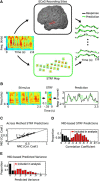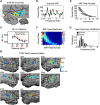Human Superior Temporal Gyrus Organization of Spectrotemporal Modulation Tuning Derived from Speech Stimuli
- PMID: 26865624
- PMCID: PMC4748082
- DOI: 10.1523/JNEUROSCI.1779-15.2016
Human Superior Temporal Gyrus Organization of Spectrotemporal Modulation Tuning Derived from Speech Stimuli
Abstract
The human superior temporal gyrus (STG) is critical for speech perception, yet the organization of spectrotemporal processing of speech within the STG is not well understood. Here, to characterize the spatial organization of spectrotemporal processing of speech across human STG, we use high-density cortical surface field potential recordings while participants listened to natural continuous speech. While synthetic broad-band stimuli did not yield sustained activation of the STG, spectrotemporal receptive fields could be reconstructed from vigorous responses to speech stimuli. We find that the human STG displays a robust anterior-posterior spatial distribution of spectrotemporal tuning in which the posterior STG is tuned for temporally fast varying speech sounds that have relatively constant energy across the frequency axis (low spectral modulation) while the anterior STG is tuned for temporally slow varying speech sounds that have a high degree of spectral variation across the frequency axis (high spectral modulation). This work illustrates organization of spectrotemporal processing in the human STG, and illuminates processing of ethologically relevant speech signals in a region of the brain specialized for speech perception.
Significance statement: Considerable evidence has implicated the human superior temporal gyrus (STG) in speech processing. However, the gross organization of spectrotemporal processing of speech within the STG is not well characterized. Here we use natural speech stimuli and advanced receptive field characterization methods to show that spectrotemporal features within speech are well organized along the posterior-to-anterior axis of the human STG. These findings demonstrate robust functional organization based on spectrotemporal modulation content, and illustrate that much of the encoded information in the STG represents the physical acoustic properties of speech stimuli.
Keywords: functional organization; human STG; human superior temporal gyrus; modulation tuning; modulotopic; spectrotemporal processing.
Copyright © 2016 the authors 0270-6474/16/362014-13$15.00/0.
Figures








Similar articles
-
A Spatial Map of Onset and Sustained Responses to Speech in the Human Superior Temporal Gyrus.Curr Biol. 2018 Jun 18;28(12):1860-1871.e4. doi: 10.1016/j.cub.2018.04.033. Epub 2018 May 31. Curr Biol. 2018. PMID: 29861132
-
Phonetic feature encoding in human superior temporal gyrus.Science. 2014 Feb 28;343(6174):1006-10. doi: 10.1126/science.1245994. Epub 2014 Jan 30. Science. 2014. PMID: 24482117 Free PMC article.
-
The Encoding of Speech Sounds in the Superior Temporal Gyrus.Neuron. 2019 Jun 19;102(6):1096-1110. doi: 10.1016/j.neuron.2019.04.023. Neuron. 2019. PMID: 31220442 Free PMC article. Review.
-
Neural Tuning to Low-Level Features of Speech throughout the Perisylvian Cortex.J Neurosci. 2017 Aug 16;37(33):7906-7920. doi: 10.1523/JNEUROSCI.0238-17.2017. Epub 2017 Jul 17. J Neurosci. 2017. PMID: 28716965 Free PMC article.
-
Stimulus-dependent activations and attention-related modulations in the auditory cortex: a meta-analysis of fMRI studies.Hear Res. 2014 Jan;307:29-41. doi: 10.1016/j.heares.2013.08.001. Epub 2013 Aug 11. Hear Res. 2014. PMID: 23938208 Review.
Cited by
-
Temporal integration in human auditory cortex is predominantly yoked to absolute time, not structure duration.bioRxiv [Preprint]. 2024 Sep 24:2024.09.23.614358. doi: 10.1101/2024.09.23.614358. bioRxiv. 2024. PMID: 39386565 Free PMC article. Preprint.
-
Sublexical cues affect degraded speech processing: insights from fMRI.Cereb Cortex Commun. 2022 Feb 16;3(1):tgac007. doi: 10.1093/texcom/tgac007. eCollection 2022. Cereb Cortex Commun. 2022. PMID: 35281216 Free PMC article.
-
Identification of the Spectrotemporal Modulations That Support Speech Intelligibility in Hearing-Impaired and Normal-Hearing Listeners.J Speech Lang Hear Res. 2019 Apr 15;62(4):1051-1067. doi: 10.1044/2018_JSLHR-H-18-0045. J Speech Lang Hear Res. 2019. PMID: 30986140 Free PMC article.
-
Rapid tuning shifts in human auditory cortex enhance speech intelligibility.Nat Commun. 2016 Dec 20;7:13654. doi: 10.1038/ncomms13654. Nat Commun. 2016. PMID: 27996965 Free PMC article.
-
Non-Invasive Mapping of the Neuronal Networks of Language.Brain Sci. 2023 Oct 13;13(10):1457. doi: 10.3390/brainsci13101457. Brain Sci. 2023. PMID: 37891824 Free PMC article. Review.
References
Publication types
MeSH terms
Grants and funding
LinkOut - more resources
Full Text Sources
Other Literature Sources
